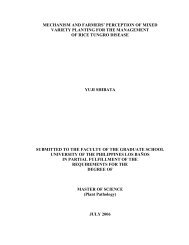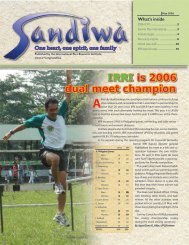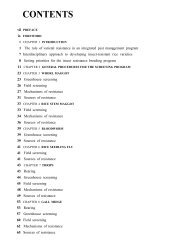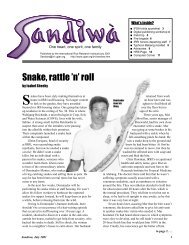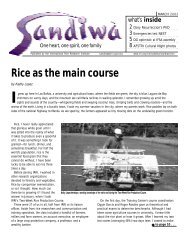Untitled - International Rice Research Institute
Untitled - International Rice Research Institute
Untitled - International Rice Research Institute
You also want an ePaper? Increase the reach of your titles
YUMPU automatically turns print PDFs into web optimized ePapers that Google loves.
Seed health management for crop production<br />
In tropical Asia, the productivity of newly released<br />
modern rice cultivars declines rapidly because of<br />
seed health problems associated with the continuous<br />
use of the seed without adequate seed health management.<br />
At IRRI, we have conducted research on<br />
seed health management since the early 1990s. The<br />
research effort has focused on understanding farmers’<br />
seed health problems in relation to crop management<br />
and production. By improving farmers’ seed<br />
health management, rice yield could be increased by<br />
5–20%. Increasing farmers’ yields generates more<br />
income and profit. The marginal cost-benefit ratio<br />
was estimated at 5, and even 10, depending on the<br />
quality of the farmers’ original seed stock for planting<br />
(T.W., unpubl. data).<br />
Seed health management is an important way of<br />
reducing pest damage and weed infestation in the<br />
field. By employing sound seed health management,<br />
farmers not only minimize the use of harmful agrochemicals,<br />
they also maximize the genetic yield potential<br />
of these modern rice cultivars. We found that<br />
the productivity of foundation seed is reduced by 1 t<br />
ha –1 in three crop seasons using current farmers’<br />
seed health management practices (L. Diaz, M.<br />
Hossain, V. Merca, and T.W. Mew, unpubl. data).<br />
Yield changes according to the level of “high-quality<br />
seed” in seed stock used by farmers. When the level<br />
of high-quality seed reached 90% of the seed stock<br />
for planting, the yield increase was not significant.<br />
In rice seed health testing, little information exists<br />
on pathogen detection frequency on seed and on<br />
which part of the seed an organism is likely to be<br />
located. This handbbok contains information on rice<br />
seed health testing that we have been carrying out for<br />
the past 20 years. We hope to offer seed health testing<br />
technicians, college or graduate students, and<br />
teachers in plant pathology or seed technology a useful<br />
guide. Information on seed health testing can also<br />
be an important means of improving crop production<br />
practices of farmers. The information contained in<br />
this handbook is based on IRRI’s rice seed health<br />
testing activities on both incoming and outgoing<br />
seeds. Thus, the material provides a reference for<br />
many seed health testing laboratories. In view of the<br />
increasing interest in international trade in rice, the<br />
handbook also serves as a basis for establishing plant<br />
quarantine guidelines for individual countries.<br />
12



